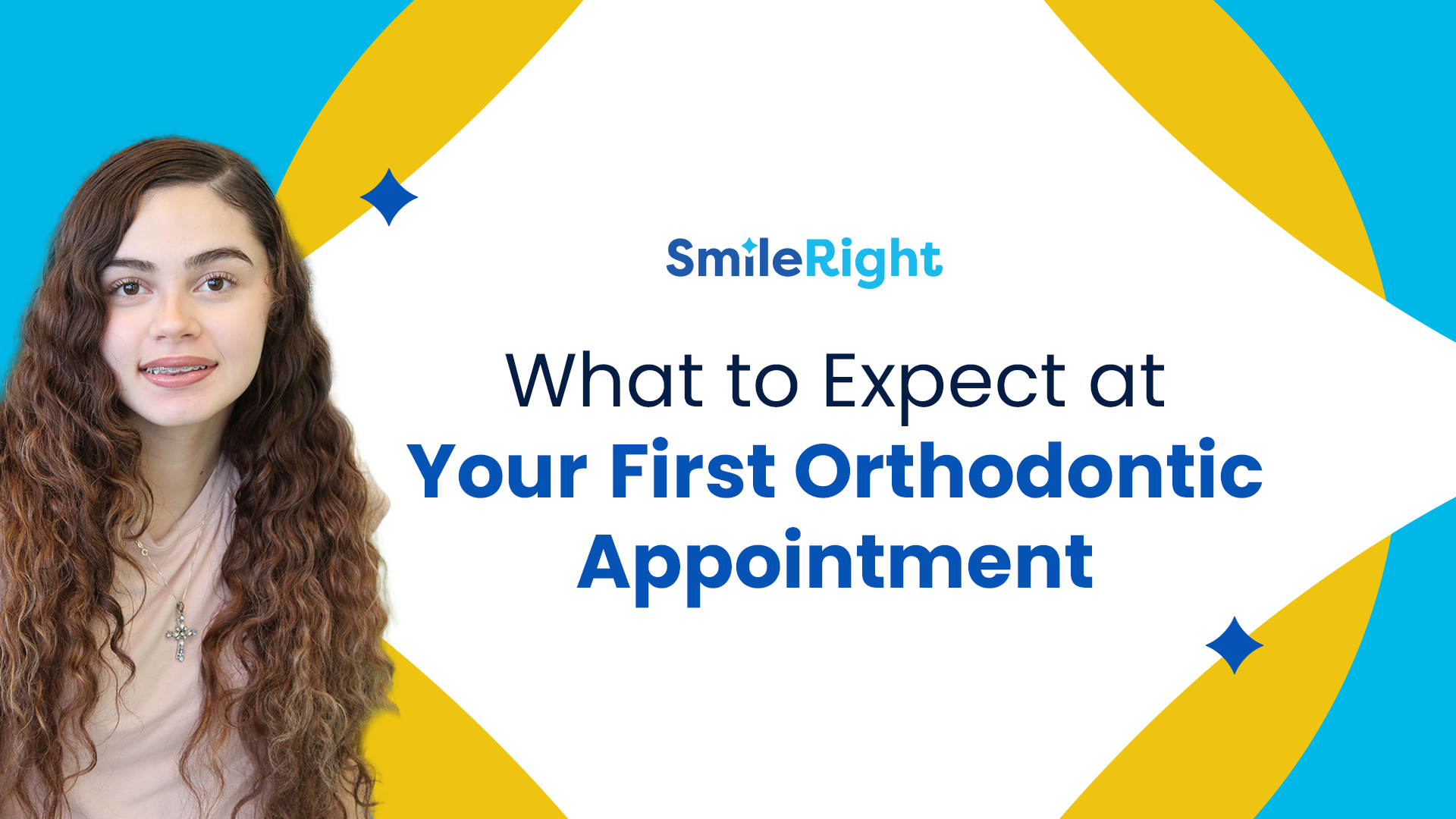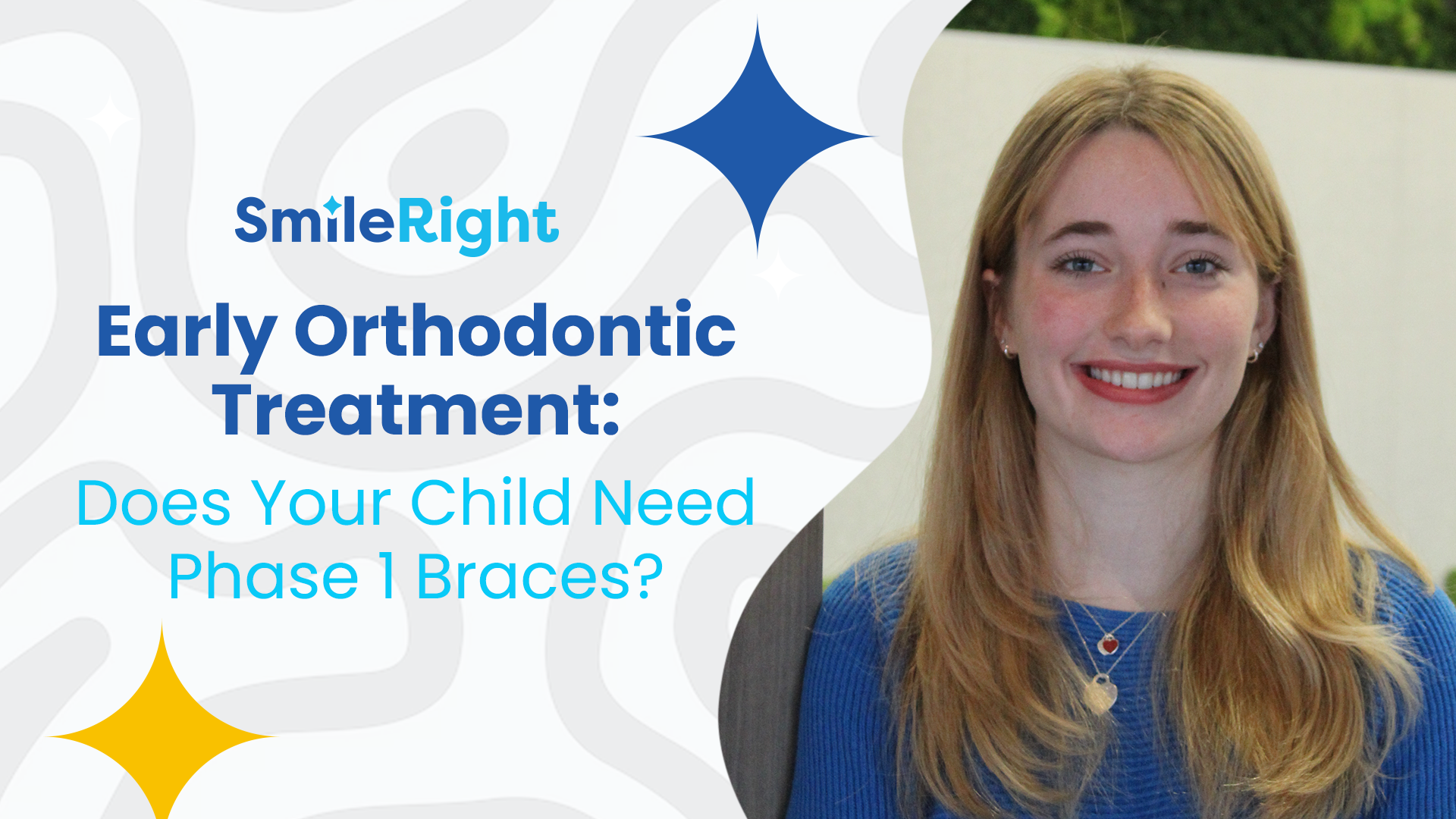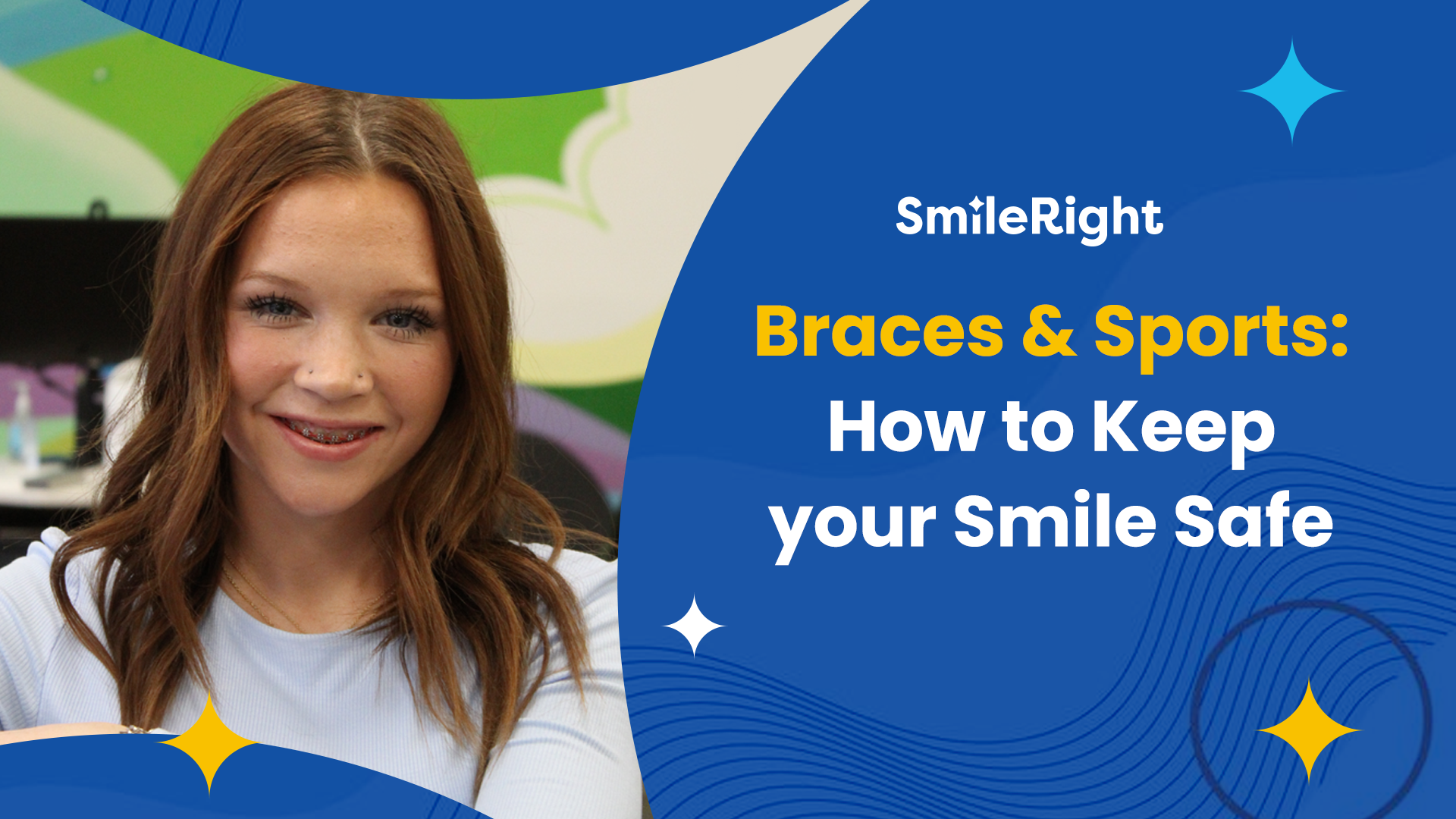Best Orthodontist In Houston, TX
Our Houston Orthodontic Blog


If you've recently scheduled your first orthodontic appointment at SmileRight—whether for yourself or your child—you may be feeling a mix of curiosity, anticipation, and maybe even a bit of nervousness. That’s completely normal. Orthodontic care is a significant step toward achieving a healthier, more confident smile. Knowing what to expect during your initial visit can help ease any anxiety and prepare you to make the most of your appointment. In this post, we’ll walk you through the typical stages of a first orthodontic visit, from the initial consultation to treatment recommendations and financial planning. Whether you're exploring braces or simply seeking professional advice, here’s what your first experience is likely to involve. 1. A Warm Welcome and Paperwork Your orthodontic journey starts at the front desk. When you arrive, a friendly receptionist or patient coordinator will greet you and ask you to complete some paperwork if you haven’t already done so online. This information typically includes: Basic contact information Medical and dental history Insurance details (if applicable) Consent forms for examination and x-rays Filling out this information helps the orthodontic team understand your health background, which is crucial in determining a safe and effective treatment plan. 2. Getting to Know You: The Consultation Once the paperwork is complete, you’ll be introduced to the orthodontic assistant or technician who will begin your consultation. The orthodontist wants to get a full picture of your oral health, so this first meeting is both a conversation and an evaluation. You’ll likely be asked questions such as: What are your main concerns about your teeth or bite? What are your goals for treatment? If the appointment is for a child, the orthodontist may also ask about habits like thumb-sucking or mouth-breathing, which can affect dental development. This is a great time to voice any questions or concerns you might have. Whether you're wondering about treatment options, duration, or lifestyle impacts (like eating or sports), don't hesitate to ask. 3. Diagnostic Records and Imaging After the initial discussion, the team will collect diagnostic records. These are essential for creating an accurate treatment plan tailored to your unique needs. Depending on the practice, this step may include: Digital X-rays: These give the orthodontist a clear view of your tooth roots, jawbones, and how your teeth are positioned. Photographs: Pictures of your teeth, bite, and facial profile help assess alignment and symmetry. These records serve as a baseline for planning and measuring progress throughout treatment. 4. The Clinical Exam Next, the orthodontist will perform a clinical exam. They will: Examine your teeth, gums, and bite Check for crowding, spacing, overbites, underbites, or crossbites Assess jaw alignment and overall oral health This hands-on evaluation, combined with your diagnostic records, allows the orthodontist to determine whether orthodontic treatment is needed and what type of treatment would be most effective. 5. Discussing Your Treatment Options Now that the orthodontist has all the necessary information, they’ll walk you through your diagnosis and potential treatment options. Depending on your case, these might include: Traditional metal braces: Durable and effective for a wide range of orthodontic issues. Ceramic (clear) braces: A more discreet alternative to metal braces. Your orthodontist will explain the pros and cons of each option, how long treatment might take, and what results you can expect. This discussion is tailored to your specific needs, so you’ll leave with a clear understanding of your recommended path forward. 6. Financial Planning and Insurance Review Once a treatment plan has been agreed upon, you’ll meet with the treatment coordinator or financial advisor to go over the costs. This step typically includes: Reviewing the total cost of treatment Discussing insurance coverage and benefits Exploring financing options or payment plans Many orthodontic practices offer flexible payment arrangements to make treatment more affordable. Be sure to ask about discounts for paying in full, family plans, or third-party financing partners. 7. Scheduling Your Next Steps If you decide to move forward with treatment, your next appointment may be scheduled immediately. Depending on your readiness and the type of treatment chosen, your first active treatment visit (such as getting braces) could be just days or weeks away. Some patients, especially children, may not need immediate treatment and might be placed in an observation phase, where the orthodontist monitors growth and development over time. 8. What to Bring and How to Prepare To ensure a smooth appointment, here’s a quick checklist of what to bring: Completed patient forms (if not submitted online) Insurance card and photo ID List of current medications and medical conditions A list of questions or concerns you may have It also helps to brush and floss beforehand so the orthodontist can get a clear look at your teeth. 9. Tips for a Successful First Visit Arrive 10–15 minutes early to complete any remaining paperwork. Bring a notebook or use your phone to jot down important information. Don’t worry if you feel nervous—orthodontic teams are used to helping patients feel at ease. Bring a friend or family member for support, especially if you’re a younger patient or just want someone to help remember the details. Final Thoughts Your first orthodontic appointment is the foundation for a journey that can improve your oral health, facial balance, and self-confidence. While it may seem like a lot of information at once, rest assured that you’re in capable hands. Orthodontists and their teams are dedicated to guiding you through the process step by step, ensuring you feel informed, empowered, and excited about your smile transformation. So take a deep breath, ask your questions, and get ready—because your journey to a healthier, more aligned smile is just beginning.

As a parent, you want your child to grow up with confidence and a healthy smile. When it comes to orthodontic care, many parents associate braces with the teenage years. However, what many don’t realize is that early intervention, often called Phase 1 treatment, can significantly impact a child’s dental development and overall oral health. So what exactly is Phase 1 orthodontic treatment, and how do you know if your child needs it? Let’s dive into what early orthodontic treatment involves, the signs your child may benefit from it, and what you can expect during the process. What is Phase 1 Orthodontic Treatment? Phase 1 orthodontic treatment, also known as early interceptive treatment, is designed for children between the ages of 6 and 10—typically while they still have a mix of baby and permanent teeth. The goal of Phase 1 is not necessarily to achieve a perfectly straight smile immediately, but to correct developmental issues early before they become more serious or harder to treat in adolescence. It’s important to note that Phase 1 treatment is often followed by Phase 2 treatment later on—usually during the teenage years—once all the permanent teeth have come in. Phase 2 typically involves full braces or aligners to fine-tune the bite and alignment. Why Consider Early Treatment? The American Association of Orthodontists recommends that children have their first orthodontic evaluation by age 7. This doesn’t mean your child will automatically need braces at that age, but it allows an orthodontist to catch any emerging issues while the mouth and jaws are still developing. Early detection can prevent more complex problems down the road. Here are some benefits of early orthodontic treatment: - Guides jaw growth to help the upper and lower jaws develop in harmony - Corrects harmful oral habits such as thumb sucking or tongue thrusting - Improves appearance and boosts confidence - Makes room for incoming permanent teeth, reducing the chance of crowding - Prevents trauma to protruding front teeth - Reduces the need for tooth extraction or jaw surgery later Signs Your Child Might Need Phase 1 Braces Every child’s development is different, but certain signs may indicate the need for early orthodontic care. If your child is showing any of the following symptoms, it might be time for an orthodontic evaluation: Crowded or misplaced teeth If there’s not enough room in the mouth for all the permanent teeth to erupt properly, early intervention can help guide them into the correct position. Early or late loss of baby teeth If your child loses baby teeth much earlier or later than average, it can disrupt the timing of permanent teeth eruption and affect bite alignment. Crossbite, underbite, or overbite An abnormal bite pattern—where the upper and lower teeth don’t meet properly—can lead to jaw pain, tooth wear, and difficulty chewing. Protruding front teeth This can increase the risk of injury and affect speech and appearance. Thumb sucking beyond age 4 or 5 Prolonged thumb or finger sucking can cause teeth and jaw misalignment. Mouth breathing or snoring These could be signs of underlying issues with the jaw or palate that orthodontics might help address. Speech difficulties Some speech problems may be linked to the alignment of the teeth or jaw. If you’ve noticed any of these signs, a consultation with an orthodontist can provide clarity on whether Phase 1 treatment is appropriate. What Does Phase 1 Treatment Involve? Phase 1 treatment varies depending on the child’s specific needs. It might involve: - Partial braces (typically on the front teeth) - Palatal expanders to widen the upper jaw - Space maintainers to hold space for permanent teeth - Functional appliances to guide jaw development - Habit-breaking appliances for thumb sucking or tongue thrusting Treatment usually lasts 9–12 months, followed by a resting period during which the remaining permanent teeth are allowed to erupt naturally. After this, your child may need Phase 2 treatment to complete the alignment process. What Happens After Phase 1? After Phase 1, your orthodontist will monitor your child’s development through regular check-ups. Once all permanent teeth have come in—usually around age 11 or 12—a second evaluation will determine whether Phase 2 treatment is needed. Phase 2 often includes full braces to refine the alignment of teeth and finalize the bite. While Phase 1 lays the foundation, Phase 2 ensures long-term stability and aesthetics. Is Early Treatment Always Necessary? Not every child needs early orthodontic treatment. Some issues are best addressed once all permanent teeth have erupted. The purpose of an early evaluation is to determine the most effective treatment plan for your child—whether that’s early intervention, waiting until the teen years, or simply monitoring development. It’s also worth considering that Phase 1 and Phase 2 treatment together may increase the overall time and cost of orthodontic care. However, for children with specific developmental concerns, early treatment can simplify or even shorten the later treatment phase, and can prevent more serious (and costly) issues down the road. Final Thoughts Every child’s smile is unique, and so is their path to achieving a healthy bite and confident grin. Early orthodontic treatment isn’t right for everyone, but for children with developing alignment or jaw issues, Phase 1 braces can make a big difference. By addressing problems early, you can help your child avoid more complex treatments later—and give them a healthy foundation for a lifetime of smiles. If you’re unsure whether your child might benefit from early orthodontic treatment, scheduling an evaluation around age 7 is a great first step. The peace of mind that comes from knowing you’re on the right track is invaluable—and your child’s future smile will thank you for it.

Sports are a fantastic way to stay active, have fun, and build confidence, but if you wear braces, there are some additional considerations to keep your smile safe while playing. Whether you’re hitting the basketball court, cycling down the street, or kicking a soccer ball, the risk of injury to your mouth and braces is real. However, with a few precautions, you can protect your braces and your smile without sacrificing your love for sports. In this blog post, we’ll discuss the best strategies to keep your braces safe during sports activities, including the importance of protective gear, specific tips for different types of sports, and how to care for your braces after an injury. 1. Why Are Braces at Risk in Sports? Braces are designed to straighten teeth over time, and this requires gentle but constant pressure on your teeth. However, when playing sports, especially contact or high-impact activities, your mouth is more vulnerable to injury. A sudden impact to the face, a fall, or even a loose ball can cause damage to both your braces and your teeth, which can delay the treatment process or even cause long-term dental issues. Injuries like cuts to the lips and gums, broken brackets, or displaced wires can not only cause pain but also interfere with the progress of your orthodontic treatment. That’s why it’s essential to take extra precautions to protect your braces while engaging in sports. 2. Use the Right Protective Gear The most effective way to protect your braces during sports is by wearing the right protective gear. The most important item to invest in is a mouthguard. A mouthguard is a soft, cushioned device worn over your teeth to prevent direct impact during sports. Not only does it protect your teeth from injury, but it also helps protect your braces from damage caused by forceful impacts. Types of Mouthguards: - Stock Mouthguards: These are pre-formed and ready to use, but they may not offer the best fit. - Boil-and-Bite Mouthguards: These are softened in boiling water, then fitted to your teeth by biting down. They offer a more custom fit than stock mouthguards. - Custom-Fitted Mouthguards: The best option for braces wearers, these are made by a dentist or orthodontist to perfectly fit your teeth and braces. They provide the best protection and comfort, although they can be more expensive. Mouthguards should always be worn during contact sports such as football, basketball, hockey, and lacrosse, as well as any sport where there’s a risk of falling or injury, like skateboarding or cycling. They are equally important for non-contact sports, like volleyball, where an accidental elbow or ball to the face can still cause injury. Most mouthguards can be purchased at places like Academy, Walmart, or Dick's Sporting Goods! 3. Be Mindful of Specific Sports Different types of sports come with different risks for those with braces. Here are some tips for protecting your smile based on the sport you play. Contact Sports (Football, Basketball, Rugby, etc.): - Always wear a mouthguard designed for braces. These sports come with a higher risk of head-on collisions or accidental contact, and a mouthguard is essential. - Consider wearing additional protective gear like face masks or helmets with a built-in chin guard if your sport allows for it. - Avoid making contact with opponents using your mouth or face. Keep your head up and practice safe, controlled movements. Individual Sports (Tennis, Track, Gymnastics, etc.): - Even though individual sports are less likely to involve body-to-body contact, there’s still a risk of injury, especially if you fall or collide with equipment. A mouthguard is still a good idea. - In gymnastics or martial arts, a fall can put significant stress on your mouth and teeth. Always be cautious with your landings and movements. Cycling and Skateboarding: - Protect your smile by wearing a mouthguard and a helmet. A fall or collision with another rider or object could damage your braces or teeth. - In skateboarding or cycling, it’s especially important to maintain proper balance and body control to reduce the risk of falling. Water Sports (Swimming, Water Polo, etc.) - Water sports generally pose a lower risk of injury to braces, but if you’re playing an active water sport like water polo, you should still wear a mouthguard. - Be mindful of the chlorine in swimming pools, as it can sometimes cause discoloration or damage to braces if not cleaned properly. Be sure to rinse your mouth and braces after swimming. Keep Up with Your Orthodontic Appointments Regular visits to your orthodontist are key to ensuring your braces are functioning properly and that your smile remains on track. These appointments are an opportunity for your orthodontist to make adjustments, check for any damage, and ensure everything is healing properly. If you’re participating in sports while wearing braces, it’s especially important to inform your orthodontist of your activity level. They might recommend adjustments, such as switching to a different type of bracket, to minimize the risk of injury or discomfort while playing sports. Conclusion Braces don’t have to hold you back from enjoying sports, but it’s essential to take the right precautions to keep your smile safe. Wearing the appropriate protective gear, like a mouthguard, being mindful of the risks associated with specific sports, and following good orthodontic care practices will help you avoid unnecessary injuries while keeping your treatment on track. Remember, sports are about having fun and staying active. With these tips, you can protect your braces and continue enjoying the activities you love. Stay safe, and keep smiling!

Braces are a significant investment of time, effort, and money, designed to straighten your teeth and give you a perfect smile. Once the braces come off, it’s tempting to think that the hard work is done. However, there’s one more essential step in the process: wearing your retainer. Many people underestimate the importance of retainers or neglect to wear them as instructed. This can lead to the very issue braces were meant to fix: misaligned teeth. Wearing your retainer after braces is crucial for ensuring that your teeth stay in their new, improved positions. In this blog post, we’ll explore why it’s so important to wear your retainer after braces, and how it can contribute to the long-term success of your orthodontic treatment. 1. Teeth Have Memory Teeth, like many other parts of the body, have a memory. When they’ve been misaligned for years, the bone, gum tissue, and ligaments around them adapt to that position. When braces are applied, they slowly move the teeth into a more desirable alignment, but this doesn’t mean that the surrounding tissues have fully adapted to the new position immediately after braces are removed. The teeth are still susceptible to shifting back to their original positions due to their “memory.” This is where retainers come in. Retainers help hold the teeth in their new positions, allowing the surrounding tissues to fully adapt to the change. Wearing a retainer ensures that the teeth stay in place while the bone and soft tissues settle into their new configurations. Without retainers, the risk of your teeth shifting back to their previous positions is significantly higher. 2. Prevents Relapse One of the primary reasons for wearing a retainer after braces is to prevent relapse—the term used when teeth begin to shift back toward their original misaligned state. After your braces are removed, the teeth are still vulnerable for a period of time. This is why orthodontists usually recommend wearing your retainer for an extended period after treatment. In some cases, this might be full-time initially and then transition to just nighttime wear after several months or years. While it’s common to see some shifting in the first few months after braces are removed, the longer you wear your retainer as instructed, the less likely it is that you will experience relapse. Ignoring this crucial step can lead to frustrating and expensive consequences, potentially requiring you to undergo orthodontic treatment all over again. 3. Long-Term Success of Orthodontic Treatment The ultimate goal of orthodontic treatment is not just to straighten teeth but to maintain that new alignment for the long haul. Without proper retention, the teeth might not stay aligned, which means all the time spent in braces could be wasted. If you’ve invested years of wearing braces, it’s essential to protect that investment and preserve your new smile. Wearing your retainer consistently plays a critical role in securing the long-term success of your orthodontic journey. For most people, the retainer must be worn for several months or even years to ensure the teeth stay aligned. Skipping this vital step can lead to the relapse of misalignment, necessitating additional visits to the orthodontist and the potential for costly and time-consuming treatments. A retainer is a simple, inexpensive way to protect your orthodontic investment and ensure that the hard work is not undone. 4. The Risk of Tooth Movement Even after your teeth have moved into their ideal positions, the jawbone that supports the teeth is still remodeling. Bone density takes time to adjust to the new alignment. This means that teeth are constantly trying to move, and even slight pressure from daily activities like chewing, talking, or clenching your teeth can cause the teeth to shift out of place. By wearing your retainer, you’re essentially stabilizing your teeth in their new positions, giving the bone and soft tissues time to fully adapt. Without this step, there’s a chance that the teeth will gradually drift back to their previous position over time. For example, if you fail to wear your retainer after the initial months following braces, the teeth could begin to crowd again or move out of alignment. 5. Preventing Unnecessary Costs Orthodontic treatment is expensive, and many people invest a significant amount of money to achieve their desired smile. Neglecting to wear your retainer can result in the need for follow-up treatments or even another round of braces, which could cost thousands of dollars. By committing to wearing your retainer, you protect your financial investment and avoid the frustration and extra costs that come with having to redo your orthodontic work. Retainers are relatively inexpensive compared to the costs of braces, and they are a simple, effective solution to maintaining your beautiful smile. Skipping out on retainer use is, in many ways, like throwing away your investment in the long term. Taking the time to wear your retainer is a small price to pay to ensure your results last. 6. Boosting Your Confidence Finally, wearing a retainer helps to maintain the results of your orthodontic treatment, ensuring that your smile stays just as bright and straight as the day your braces came off. When you spend time and effort to straighten your teeth, it can significantly boost your confidence and improve your overall appearance. You may find that your self-esteem increases as you feel more comfortable showing off your smile. However, if you neglect to wear your retainer and your teeth shift back, you might find yourself feeling disappointed and frustrated. Wearing a retainer helps to preserve the confidence boost you gained from your orthodontic treatment and ensures that you can continue to enjoy a beautiful, straight smile for years to come. Conclusion Wearing your retainer after braces is not just a formality—it is an essential part of the process of maintaining a straight, beautiful smile. Teeth have a tendency to shift back to their original positions, and without retention, all of the time and effort spent on braces could be wasted. It’s critical that you follow your orthodontist’s instructions and wear your retainer as prescribed. In the long run, wearing a retainer will save you from unnecessary expenses, prevent the frustration of tooth movement, and ensure the lasting success of your orthodontic treatment. So, if you’ve recently finished with braces, take the extra step to keep your teeth in place. Your smile—and your investment—will thank you for it!


